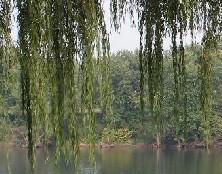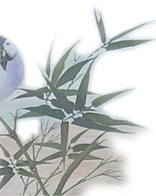|
|
|
 |
English Lesson 006: "Intone" or "Ode to" a Willow?
By Mr.Neil James (Canada)
|
 |
 Hi, friends, after reading the letter below from Mr. Neil James, I do feel it is very helpful, especially the translation of the title. When I was translating, I did think of for a long time and checked much data for choosing a best suitable word. Now I think Mr.Neil James' choice is better than mine. :-) I do appreciate Mr. Neil James has done for the web site. I really appreciate his great help. :-) Hi, friends, after reading the letter below from Mr. Neil James, I do feel it is very helpful, especially the translation of the title. When I was translating, I did think of for a long time and checked much data for choosing a best suitable word. Now I think Mr.Neil James' choice is better than mine. :-) I do appreciate Mr. Neil James has done for the web site. I really appreciate his great help. :-)
Now, I would like to publish his letter as a wonderful English lesson and hope it is helpful to you and all of the friends who are needing help. :-)
If you have any questions, comments and suggestions, please write to shirley@ebridge.cn. You are welcomed.
--Shirley
Thur., Nov 3, 2005
Hi Shirley;
I have enjoyed reading these classic Chinese poems. They are quite beautiful in their simplicity.
You titled this one "Intone a Willow". I don't think this is quite right. "Intone" is a recitation of a prayer with prolonged sounds. Much like you would hear in a temple, like a chant.
That really doesn't apply to this poem. He Zhizhang is paying tribute to this beautiful unique tree. In poetic terms this is more of an "ode". I believe most odes have a rhyme scheme so this is a bit of a technical stretch calling it an ode but it is a much better choice of word.
Here is your translation and vocabulary. I cannot do the translation as you have but I have rephrased it and offer my version of the poem. I hope you like it
***************************************
MAIN MEANING OF THE POEM LISTEN TO SHIRLEY SANGE THE
POEM:
A tall willow is dressed up by the leaves as jade,
Its twigs are hanging as ten thousand green silk
ribbons
I wonder who has cut out of the thin leaves,
The spring wind in February is just like a pair of
scissors...
CHINESE PRONUNCIATION:
þóºþÄëÕªåµêÉõ©ÇµáæÚ½ÿ -- bi4 yu4 zhuang1 cheng2 yi1 shu4
gao1,
õ©çµØíÕ×éõ©ïþ╗┐õ©Øþ╗ª -- wan4 tiao2 chui2 xia4 liu4 si1
tao1ÒÇé
õ©ìþƒÑþ╗åÕÅÂÞ░üÞúüÕç║ -- bu4 zhi1 xi4 ye4 shui2 cai2 chu1,
õ║îµ£êµÿÑÚúÄõ╝╝Õë¬ÕêÇ -- er4 yue4 chun1 feng1 si4 jian3
dao1ÒÇé
NEW WORDSLISTEN TO SHIRLEY SANGE THE POEM:
þóºþÄë: bi4 yu4 -- jade, jasper
Õªå:zhuang1 cheng2 -- dress up
成:cheng2 -- become, turn into
õ©Çµáæ: yi1 shu4 -- a tree
Ú½ÿ: gao1 -- high, tall
õ©ç: wan4 -- ten thousands
µØí: tiao2 -- twig, piece
Õ×éõ©ï: chui2 xia4 -- hang, trail
þ╗┐:lu4 -- green
õ©Ø:si1 -- a threadlike thing
þ╗ª: silk ribbon
õ©ìþƒÑ:do not know
þ╗åÕÅÂ:thin leaf/leaves
Þ░ü:who
ÞúüÕç║:cai2 -- cut out
õ║îµ£ê: February
µÿÑÚúÄ: chun1 feng1 -- spring breeze, spring wind
õ╝╝: si4 -- as, like, same as
Õë¬ÕêÇ: jian3 dao1 -- a pair of scissors
CHINESE CHARACTERISTICSLISTEN TO SHIRLEY SANGE THE
POEM:
þóºþÄëÕªåµêÉõ©ÇµáæÚ½ÿ´╝î
õ©çµØíÕ×éõ©ïþ╗┐õ©Øþ╗ªÒÇé
õ©ìþƒÑþ╗åÕÅÂÞ░üÞúüÕç║´╝î
õ║îµ£êµÿÑÚúÄõ╝╝Õë¬ÕêÇÒÇé
*********************************
This is my version of the poem
Ode to a Willow
A tall tree clad in leaves of jade, Branches streaming thousands of green silk ribbons, I wonder at who has shaped these thin leaves, Perhaps the February spring wind is the scissors.
I used branches instead of twigs and rather than specify the number of leaves as "ten thousands" I just left it at "thousands" since the leaves are really uncountable and the word "thousands" conveys the same meaning as a specific number.
I have the vision of a man admiring the tree and wondering at its creator. The leaves reappear in the spring, the same time as the warm spring winds breath life into the landscape.
I realize that "perhaps" is not shown in the Chinese  characters but the addition of this word makes the thought process flow. The author speculates about how the tree is shaped and concludes, whimsically that perhaps the spring wind has a role in the beautiful creation. characters but the addition of this word makes the thought process flow. The author speculates about how the tree is shaped and concludes, whimsically that perhaps the spring wind has a role in the beautiful creation.
This is my feelings as I read the poem.
Hope you like my translation
Jim
|
|
|
|
| |
| |
|

